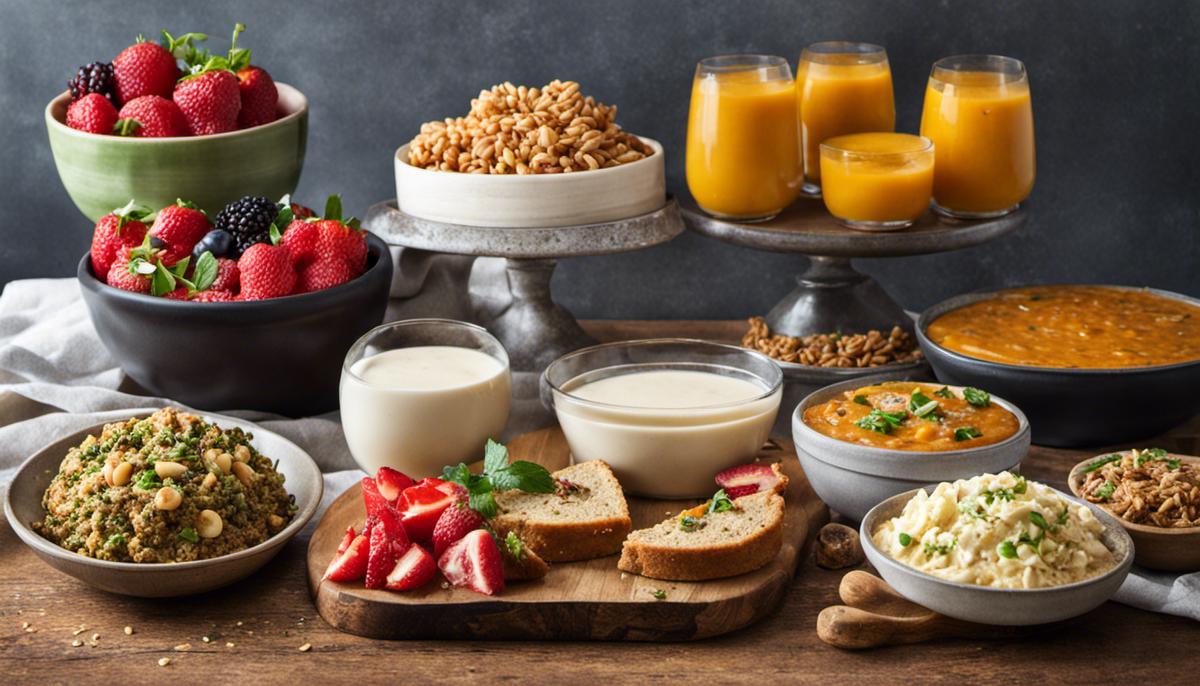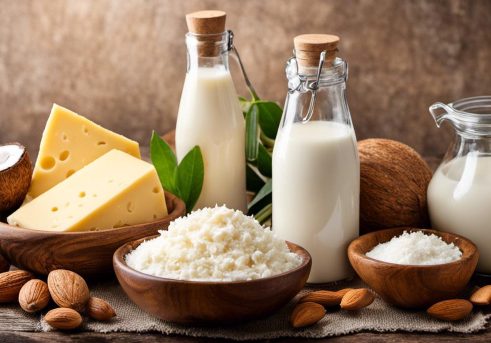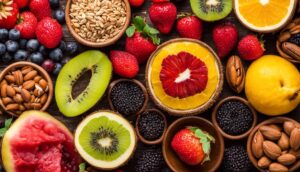If you’re considering ditching dairy for health, ethical, or dietary reasons, you might find yourself a bit puzzled about how to navigate the culinary landscape without the familiar staples such as milk, cheese, and butter. Whether you wish to go entirely dairy-free or simply want to expand your kitchen repertoire, this enlightening journey into dairy substitutes and dairy-free cooking techniques will be an indispensable resource. This comprehensive guide delves into the vast range of non-dairy substitutes – almond, soy, and coconut milk, cashew cheese, olive oil, and more – examining their nutritional content, flavor profiles, and functionality in recipes.
Understanding Dairy Substitutes
Savoring Non-Dairy Delights: Unveiling Nutritional Benefits & Flavor Profiles of Popular Dairy Substitutes
The culinary world has always been driven by the quest for innovation and diversity. Enter dairy alternatives – a category of food that makes the tastebuds tingle with curiosity. A love for food isn’t simply about eating what’s on the plate; it’s about exploring flavors, challenging traditional concepts, and making every meal an adventure. So let’s delve into nature’s bounty and discover the rich flavors and inherent nutritional benefits of popular dairy substitutes.
Almond Milk:
With its delicately sweet and nutty profile, almond milk has rightfully earned its place among dairy substitutes. Naturally low in calories and sugar, it’s also rich in Vitamin E and good fats. It’s a perfect companion for a cup of silky latte or a bowl of warm granola, adding an otherworldly twist to breakfast staples.
Soy Milk:
A potent protein powerhouse, soy milk stands strong with its slightly creamy and subtly sweet flavor. A fantastic source of potassium and fortified with vitamins B12 and D, it’s not just about its smooth, milk-like texture, but the nutritional punch it packs. Ideal for transforming your favorite smoothies, sauces, or soups into nutrient-dense feasts.
Coconut Milk:
Rich and creamy with an aroma that transports you to tropical shores, coconut milk offers distinct diversity in flavor. It is bursting with healthful benefits, including digestion-friendly fiber and heart-healthy fats. The mildly sweet taste can elevate the flavor quotient of your curries, desserts, and rice dishes.
Oat Milk:
Oats aren’t just about hearty breakfasts anymore. With its rise in popularity, oat milk brings a creamy, slightly sweet, and almost grain-like flavor to the table. It’s packed with B vitamins, fiber, and provides slow-release energy. Try it in your morning coffee or as a delightful base for homestyle bechamel sauce.
Rice Milk:
The lightest in the pack, rice milk carries a uniquely thin, sweet, and almost starchy profile. Bestowing modest nutritional perks, it’s high in carbohydrates, fortified with calcium, and is the most hypoallergenic of all substitutes. Loved by smoothie enthusiasts and cake-bakers alike, it’s sure to add a delicious touch to your cherished recipes.
Cashew Milk:
Luxuriously creamy yet slightly less nutty, cashew milk stands out for its versatility. It’s low in calories and high in vitamins E and K. This creamy concoction lends itself well to any recipe, making your creamy soups creamier or your homemade ice-creams smoother and richer.
One’s joy of cooking and eating doesn’t simply come from the act itself, but the journey of exploration, of experimenting with a sea of flavors and textures new and familiar. So, go ahead and challenge the dairy norm. Dive into the world of dairy substitutes, not only for their varied nutritional offerings but also their unique, succulent flavor profiles. Allow these alternatives to transform your culinary adventures into nutrient-loaded, flavor-packed experiences. After all, good food is all about deep dives into never-before-seen territory and reaping immensely satisfying rewards. Embark on this delicious exploration of dairy substitutes and unearth a trove of flavors – all while inculcating a newfound respect and love for these innovative substitutes.

Mastering Dairy-Free Cooking Techniques
Discovering that someone in your household, or even you, is lactose intolerant can be a revelation. Is it the end of creamy pasta or rich, comforting soups? Absolutely not! Dairy-free doesn’t mean taste-free. This new culinary adventure can open up doors to a world of flavors and cooking techniques that will leave your taste buds exploding with delight. So buckle up, passionate food enthusiasts, as we take a deep culinary dive into how you can adapt cooking methods for dairy-free recipes.
Let’s start with butter which is a staple in many baking recipes. When going dairy-free, you can still enjoy the same richness by substituting it with alternatives like margarine, coconut oil, or even applesauce. Margarine essentially mimics the creaminess of butter while coconut oil adds a distinctive taste that can complement certain recipes. Applesauce, though it may sound strange, actually works wonders in most baking recipes. Just ensure you reduce the amount of sugar you use, as applesauce itself can be quite sweet.
Cheesy cravings can be quite hard to quell when you are on a dairy-free diet. So when the call for cheese in your pasta or a decadent gratin is too strong to ignore, cue nutritional yeast. This golden, flaky ingredient has the uncanny ability to simulate the taste of cheese without any actual dairy in it. Known as ‘nooch’ among vegans, it’s a must-have in a dairy-free pantry.
Custards and creamy pies can also fall into the dairy-free category with some clever substitutions. Silken tofu can be a revelation. Yes, you read right, tofu! When blended, this ingredient can offer a creamy, rich texture similar to a heavy cream. If a recipe calls for sweetened condensed milk, coconut milk cooked down with sugar makes an excellent alternative.
Speaking of heavy cream, there are a handful of ingenious dairy-free swaps that can retain that creamy element. Canned coconut cream serves as a perfect swap and lends an exotic flavor to dishes. If you prefer a more neutral taste, cashew cream can be your go-to. Simply soak cashews overnight and blend them with a little bit of water to achieve a texture similar to cream.
When it comes to dairy-free yogurt, coconut milk yogurt and almond milk yogurt hold their own. Both work flawlessly in recipes that call for traditional dairy yogurt, but they do bring mild flavors of their own to the table.
Going dairy-free can feel restrictive initially, but it truly is an exciting opportunity to unlock new flavors and dishes. Why stick to the same-old when the entire culinary rainbow is waiting for you? Happy cooking, fellow food enthusiasts!

Creating Dairy-Free Recipes
Whether due to dietary restrictions, health preferences, or personal values, mastering the world of dairy-free cooking can indeed be a delightful exploration of taste and creativity. Bursting with the opportunity for innovation, one may wonder about the untapped potential of delightful dairy-free gastronomy. Well, fear not fellow food lovers, for there’s a veritable treasure trove of taste sensations to be discovered by way of savory sauces, cheeses and dairy-free desserts that beckon the palate for more.
In the realm of sauces, where often dairy fills the role of thickener and flavor enhancer, one might feel at a loss, but let’s take a walk down the flavorful lanes of cashew and miso. By combining soaked cashews and miso paste, a wonderfully rich and creamy sauce, perfect for pasta, can be created. Miso is a soy-based product providing a savory, umami flavor that can be a taste-tingling sensation when combined with the creamy, nutty flavor of cashews. This simple combination can remarkably enhance the oomph factor of any dairy-free dish.
Onto the world of cheese substitutes – a game changer is the ever versatile tofu. Appreciated for its chameleon-like ability to take on the flavors of its accompanying ingredients, tofu can be blended into a creamy ‘ricotta’ style cheese or, when seasoned and baked, can resemble a tasty feta. It’s a heart-healthy, protein-rich, calcium-packed ingredient that makes an excellent addition to pizza, pasta, or salads.
And what’s a feast without a little sugar and spice? Desserts have always been the crown of a meal, sometimes leaving one salivating with anticipation. To our delight, we can substitute traditional dairy products with avocado – yes, avocado! This rich, creamy fruit is known for its health benefits, but its potential in desserts is perhaps the most exciting for dessert lovers. For instance, its smooth texture can create a decadently creamy chocolate mousse, and its subtle, mellow flavor pairs incredibly well with the bold notes of cocoa, creating a perfect balance between the two.
Indeed, shouldn’t we take joy in how the culinary world adapts, opens to a trade of flavor, and embraces innovations? So, whether you’re lactose intolerant, vegan, or simply just in the mood to try something new, there’s a deluge of dishes awaiting to be concocted from the limitless potential of dairy-free ingredients. Break the mold, spice up your cooking, and embark on this culinary journey, for as it is said often, variety is the spice of life!

Photo by shutters_guild on Unsplash
Mastering the art of dairy-free cooking does not necessitate sacrificing taste or satisfaction. Many non-dairy substitutes provide rich, savory flavors and desirable textures that can rival their dairy counterparts. From understanding the complexities of dairy substitutes to adapting methods to accommodate dairy-free ingredients, and finally creating your own delightful dairy-free dishes, every step of the journey can be an exciting culinary adventure. Be open to experimentation, and you’ll see how easy and fulfilling it is to create your own dairy-free cuisine that is not just healthy but also delicious and creative.





